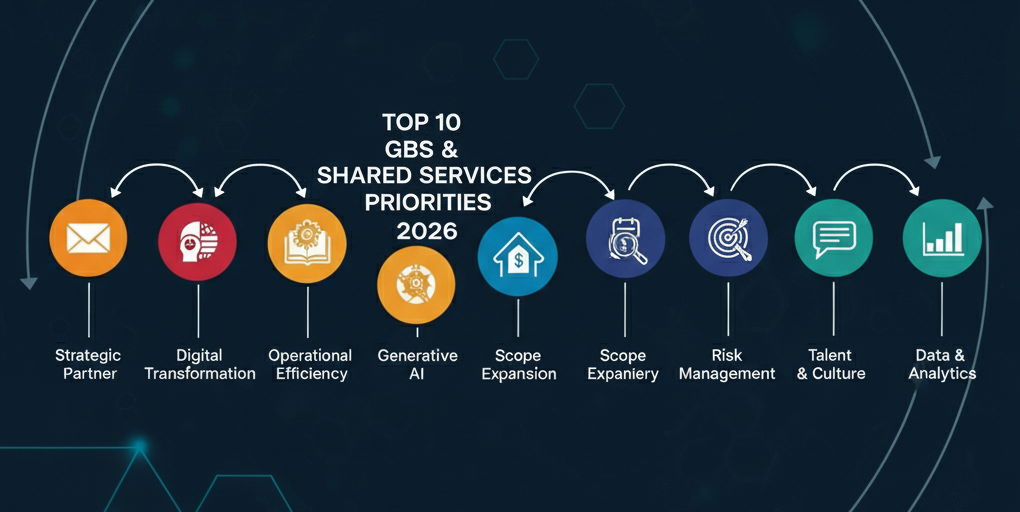
Global Business Services (GBS) has evolved from back-office support to a strategic growth engine. With the shared services market projected at $111.3B by 2025 and global digital transformation spend surpassing $2.5T, GBS is now firmly established as a business-critical enabler.
In an era of economic volatility, rapid tech change, and rising expectations, leaders are prioritizing efficiency, agility, and enterprise value. Here are the top priorities shaping 2026, backed by market data, executive insights, and real-world examples.
1. Elevating GBS to a Strategic Business Partner
76% of GBS units now report to the C-suite, underscoring their role in driving growth and working capital improvements. As Deloitte notes, cost reduction alone is a “deteriorating value proposition.”
Still, only 41% of companies believe their shared services deliver tangible value (BCG). To close the gap, leaders are shifting from transactional KPIs to value-based measures like revenue enablement and decision support. Many are embedding Centers of Excellence in analytics and process improvement directly into business lines, positioning GBS as an indispensable internal consultant.
2. Customer-Centric Service Excellence
73% of GBS organizations rank service quality among their top three priorities (SSON Analytics), second only to cost savings. More than half explicitly identify customer experience as critical.
To deliver, GBS units are rolling out clear SLAs, real-time feedback loops, and even “customer success” roles, borrowing from external service models. Enterprises now expect GBS to function as a true business partner, delivering agility, automation, and actionable insights.
3. Operational Efficiency and Cost Optimization
Efficiency remains the foundation: 90% of organizations cite it as their top driver (Deloitte), with nearly half reporting 20%+ savings from their models. For large enterprises, this translates into tens or hundreds of millions annually.
The focus has shifted to intelligent cost optimization using automation, self-service, and process redesign to reduce waste while improving quality. Leading GBS groups reinvest savings into analytics, insights, and service improvements, creating a cycle of continuous value.
4. Digital Transformation and Intelligent Automation
90% of GBS organizations now play a role in their company’s digital agenda, yet only 20% rate themselves as advanced (SSON).
The shift is toward end-to-end automation: AI-assisted workflows, document processing, and integrated platforms. Starbucks’ Digital Process Automation COE demonstrates the impact—35+ RPA use cases and 15 workflow apps have helped double annual savings growth. For 2026, the priority is scaling enterprise-wide automation and embedding digital into every workflow.
5. Generative AI and Next-Gen Technologies
GenAI adoption has skyrocketed: from 10% in 2023 to 80% experimenting by late 2024, with more than half piloting (SSON).
Early adopters report 54% faster service delivery and 51% higher output quality. Use cases include chatbots, document processing, automated reporting, and predictive analytics. RPA remains the #2 investment area, showing leaders are combining traditional automation with GenAI for a complete toolkit. Nearly 60% of GBS groups are using external partners to accelerate adoption.
6. Expanding Scope and Moving Up the Value Chain
GBS is extending beyond transactional work. Nearly 50% of leaders plan to expand into decision support, research, or end-customer services, with another 35% considering it (SSON).
Portfolios now include data analytics (43%), master data management (50%), tax (43%), statutory reporting (41%), and call center support (33%). Unilever and Procter & Gamble already use GBS for analytics-driven insights, supply chain support, and innovation. For 2026, 77% of GBS units plan scope expansion, with many extending into new geographies and business lines.
7. Global Delivery Model and Location Strategy
85% of enterprises now run on the GBS model (Deloitte), supported by multi-location networks for resilience, cost, and talent.
Nearshoring is accelerating: by 2026, 50% of firms will add hubs in Latin America or Europe, with Mexico, Portugal, and Poland joining India and the Philippines as key centers (SSON). Hybrid models, balancing captive and outsourced delivery are becoming the norm, enabling 24/7 operations, risk mitigation, and global talent access.
Conclusion
As GBS leaders step into 2026, the mandate is clear: deliver efficiency and enterprise value in equal measure. Cost optimization remains vital, but the future belongs to organizations that pair operational excellence with strategic impact, driving growth, agility, and sustainability.
No longer back-office utilities, today’s GBS units serve as digital nerve centers: scaling AI and automation, embedding analytics, expanding scope, and optimizing global delivery. They are customer-centric partners, not just cost managers, ensuring, as Auxis puts it, that “customers come for the price but stay for the value.”
By doubling down on these top 10 priorities—from strategic partnering and service excellence to next-gen tech, talent, and ESG—Shared Services organizations are positioning themselves at the forefront of business evolution. The next chapter promises both disruption and opportunity, and GBS will be pivotal in powering intelligent, agile, and sustainable enterprises worldwide.
Sources:
- SSON Analytics: State of the Shared Services & Outsourcing Industry Report 2025[2][51]Auxis (via SSON Research): “10 Shared Services Trends Shaping the GBS Industry in 2025.” [8][19]Deloitte: 2025 Global Business Services Survey Findings[52][4]The Hackett Group: Key Issues Study 2024: GBS Priorities[3]EY: “How GBS is driving sustainable business transformation”[48][47]SSON Research: GBS Executive Insights and Quotes[53][27]Starbucks GBS Case: PegaWorld 2024 Presentation[17][18]Deloitte Press Release: GBS Model Impacts (Aug 29, 2025)[54][55]SSON Analytics: Shared Services Market and GBS Targets[1][56]Auxis/SSON: Shared Services Trends on Talent & Locations[29][41]

